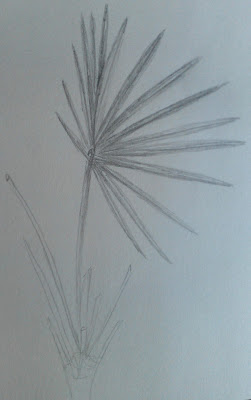Before I began painting on the large paper I did a few practices.
So first I began with practicing sketching the plant. I decided to later use a more side view of the plant rather than the one above. In the drawing above the leafs closest to the camera appeared bigger than the ones farther away, however it looks odd in the drawing.
Above is my completed practice painting. I worked on watercolor paper and played with the variety of greens and brushes. The leafs are different colors as I played with more yellow tones or blue tones. I decided that the leafs needed to have a blue tinge to them. Also, I painted the roots as if they were sitting in water as shown in one of the reference photos.
Above is my completed project. I added less leafs than before to keep the overall painting simple. I added a textured background wash to simulate background foliage. To make the roots appear to be standing in water I added extra water to the ends of the roots to fade them. The leafs have a blue tinge to them and some have the center line depending on the angle.
I feel that I need more practice with watercolor. I did not always have the patience to wait for the paint to dry before adding second layers. In addition, I believe that the leafs and stems need more definition so that they don't appear to be flat. Overall, I am pleased with how the project finished and I feel that it does accurately represent the Red Mangrove plant.






















